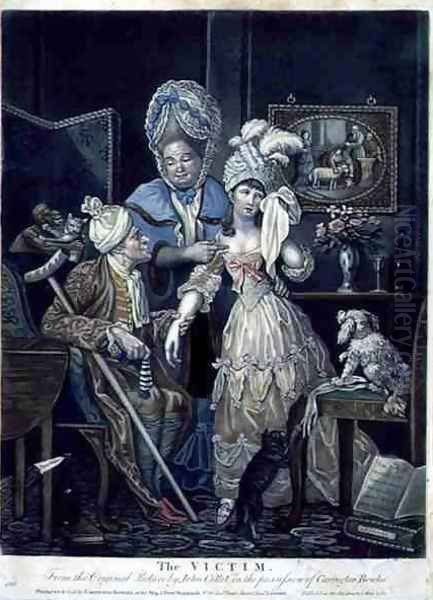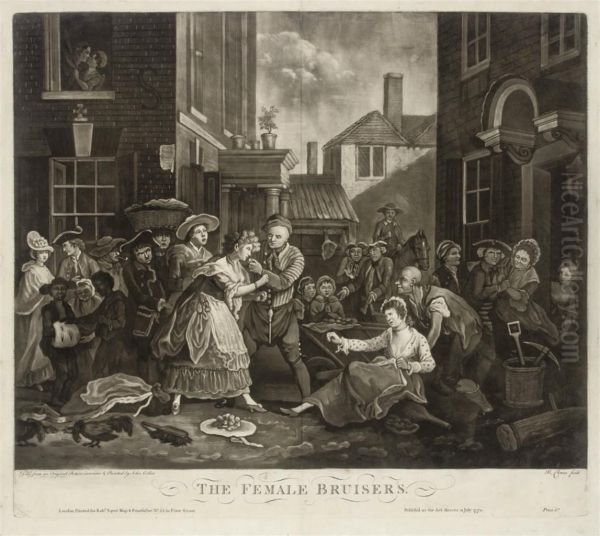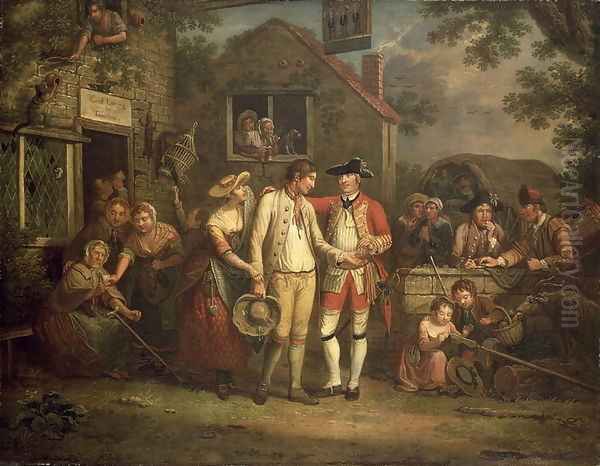John Collet (1725-1780) stands as a noteworthy figure in the vibrant landscape of eighteenth-century British art, particularly celebrated for his humorous and satirical depictions of contemporary life. While perhaps not as universally recognized today as some of his towering contemporaries, Collet carved a distinct niche for himself, earning the moniker "the second Hogarth" for his keen observational wit and his engagement with the social mores, follies, and fashions of his time. His work provides a fascinating window into the bustling, complex, and often contradictory world of Georgian London.
Early Life and Artistic Formation
Born in London in 1725, John Collet was the son of Henry Collet, a successful merchant who held the distinguished position of Lord Mayor of London. This prosperous background afforded young John a comfortable upbringing and access to a good education, where he reportedly focused on art and literature. Unlike many artists who struggled with financial insecurity, Collet's familial wealth provided a degree of stability that would later be augmented by a significant inheritance, allowing him a measure of independence throughout his career.
His formal artistic training began under the tutelage of John Lambert, a landscape painter known for his work at the Foundling Hospital alongside William Hogarth and for his theatrical scene painting, notably at Covent Garden Theatre. This initial instruction would have provided Collet with foundational skills in composition and paint handling. Following this, Collet further honed his abilities at the influential St Martin's Lane Academy in London.
The St Martin's Lane Academy, effectively re-established by William Hogarth around 1735 from an earlier academy founded by Louis Chéron and John Vanderbank, was a crucial hub for artistic development in London before the founding of the Royal Academy of Arts in 1768. It was less a formal, structured school and more of a cooperative where artists could draw from live models and exchange ideas. Figures like Francis Hayman, a notable history and genre painter, and later, Thomas Gainsborough and Joshua Reynolds, albeit briefly for the latter, were associated with it. This environment, steeped in Hogarth's spirit of artistic independence and critical observation, undoubtedly shaped Collet's outlook and artistic direction.
The "Second Hogarth": Style, Themes, and Satire

John Collet's artistic identity is inextricably linked to that of William Hogarth (1697-1764), the pioneering master of English satirical art. The comparison, dubbing Collet "the second Hogarth," was contemporary and speaks volumes about his perceived style and thematic concerns. Like Hogarth, Collet turned his gaze upon the society around him, employing humor, caricature, and narrative to comment on human behavior, social customs, and moral issues.
His style, while indebted to Hogarth, often possessed a lighter, more overtly humorous touch, sometimes lacking the biting moral severity found in Hogarth's major series like A Rake's Progress or Marriage A-la-Mode. Collet's satire could be gentler, focusing on the absurdities of fashion, the foibles of courtship, the pretensions of social climbers, and the everyday dramas of urban and domestic life. He excelled in capturing expressive figures and dynamic, often crowded, compositions that told a story at a glance.
Collet's subjects were drawn from the rich tapestry of London life. He depicted scenes of amorous encounters, domestic squabbles, the bustling activity of taverns and public spaces, and the often-comical pursuit of fashionable trends. His works frequently explored the interactions between different social classes and the evolving, sometimes contested, roles of men and women in society. This engagement with gender, particularly the blurring or subversion of traditional stereotypes, is a recurring element in his oeuvre.
Notable Works and Their Reception
John Collet was a prolific artist, and while many of his original paintings may be less widely known today, their essence was broadly disseminated through prints, a common practice that greatly expanded an artist's reach in the eighteenth century. Publishers like Carington Bowles played a significant role in popularizing Collet's designs.
Among his recognized works is the series The Four Seasons. Such series, depicting Spring, Summer, Autumn, and Winter, were popular subjects, allowing artists to explore different activities, costumes, and atmospheric effects associated with each time of year. Collet would have imbued these scenes with his characteristic humor and social observation, likely portraying contemporary figures engaged in seasonal pastimes, perhaps with a satirical undertone commenting on their behavior or attire.

Another notable piece, Tight Lacing, or Fashion before Comfort, directly addresses the absurdities of fashion. This work would have caricatured the extreme practice of tight-lacing corsets to achieve a fashionable, narrow waist, often at the expense of health and comfort. Such a theme was ripe for satirical treatment, highlighting the vanity and conformity inherent in societal trends. This subject was also tackled by other caricaturists of the period, reflecting a broader societal amusement and critique of such extreme fashions.
The series Modern Love further exemplifies his engagement with contemporary social rituals. This set of paintings, likely depicting various stages and pitfalls of courtship and marriage in the "modern" (i.e., eighteenth-century) style, would have offered ample opportunity for humorous commentary on romantic entanglements, societal expectations, and the often-mercenary aspects of marital alliances. Carington Bowles and his partner Samuel Carver are known to have purchased this series between 1777 and 1780 for reproduction as prints.
The Victim is another title associated with Collet, again suggesting a narrative with a moral or humorous point, likely involving an unfortunate individual caught in some comic or compromising situation. The fact that Bowles produced colored mezzotint versions of such works, sometimes in contrasting color pairs, indicates their commercial appeal and the sophisticated print market of the time.
Collet's works were regularly exhibited at public venues in London, such as the Free Society of Artists, which provided an important platform for artists outside the more established (and later, Royal) academic structures. His popularity is attested by the frequency with which his designs were engraved and sold in the prominent print shops that lined the streets of London, their windows serving as veritable public galleries.
Collet and the London Art World: Publishers and Peers
The eighteenth-century London art world was a dynamic and increasingly commercialized environment. For an artist like Collet, whose work lent itself well to reproduction, relationships with print publishers were crucial. Carington Bowles (1724-1793) was a key figure in this regard. Bowles, operating from his famous shop near St. Paul's Churchyard, was a major publisher of maps, portraits, and, significantly, satirical and humorous prints known as "drolls." He recognized the public appetite for Collet's brand of humor and social commentary.

The collaboration was mutually beneficial: Collet's designs provided popular content, and Bowles's printmaking and distribution network ensured they reached a wide audience, both in Britain and its colonies. Other publishers, such as John Smith and Robert Sayer (who later partnered with John Bennett), were also active in this competitive market, and Collet's work was part of this broader print culture. Robert Sayer, for instance, was a prolific publisher who also issued works by artists like Johan Zoffany and Richard Houston. Thomas Bradford is another publisher noted to have disseminated Collet's work.
While Collet was known for his satirical focus, the London art scene was diverse. Portraiture reigned supreme, with artists like Joshua Reynolds, the first President of the Royal Academy, and Thomas Gainsborough achieving immense fame and fortune. Landscape painting was also gaining prominence, with figures like Richard Wilson and the early works of Gainsborough himself. Historical and mythological subjects, championed by the Royal Academy, were considered the highest genre, though perhaps less commercially popular than portraits or satirical prints. Artists like Benjamin West (an American who became President of the Royal Academy after Reynolds) and Angelica Kauffman excelled in this area.
Collet's specific interactions with these leading figures are not extensively documented, but he operated within the same artistic ecosystem. His training at St Martin's Lane placed him in a milieu that included artists who would go on to become major names. His choice to specialize in satire, however, aligned him more closely with the tradition of Hogarth and the burgeoning market for graphic satire, a field that also included amateur talents like Henry William Bunbury and more politically focused artists like James Sayers. Paul Sandby, known more for his topographical watercolors, also produced caricatures.
Social Commentary, Gender, and Everyday Life
A significant aspect of John Collet's work is its commentary on social norms and, particularly, on gender roles. His satirical prints often depicted men and women in situations that highlighted or subverted contemporary expectations. For example, the print A morning frolic, or, The transmutation of sexes, reportedly based on a Collet original and published by Bowles, explicitly plays with gender reversal, a theme that titillated and amused eighteenth-century audiences.
His depictions of women, whether struggling with fashion, engaging in courtship, or managing domestic affairs, often carried a layer of critique. He is noted for satirizing female horse-riding habits, perhaps mocking the affectations or perceived masculinity of women adopting such pursuits. However, his satire was not exclusively directed at one gender; men too were subject to his humorous scrutiny, portrayed in their vanities, vices, and vulnerabilities.
Collet's art captured the pulse of everyday life. His scenes are populated with a cast of characters recognizable to his contemporaries: fops and dandies, coy maidens and assertive matrons, lecherous old men and naive youths, servants and masters. Through their interactions, Collet explored themes of love, marriage, social aspiration, deception, and the simple absurdities of human existence. His work reflects a society grappling with change, with new wealth, shifting class boundaries, and evolving ideas about propriety and behavior.
The humor in Collet's work, while sometimes broad, often relied on a shared understanding of social codes and a collective amusement at their transgression. His art functioned as a form of social mirror, reflecting and gently mocking the preoccupations of his age. This focus on the minutiae of daily life, filtered through a satirical lens, distinguishes his work from the grand historical narratives or idealized portraits that dominated other sectors of the art market.
Later Life, Legacy, and Re-evaluation
John Collet never married. In his later years, he inherited a considerable fortune, which, combined with his family's existing wealth, ensured he lived comfortably and independently, free from the financial anxieties that plagued many artists. He resided in Chelsea, a fashionable district of London, on Cheyne Walk, an area historically popular with artists and writers. He passed away there on August 6, 1780 (some sources state June 6), and was buried in the local churchyard.
During his lifetime, Collet enjoyed considerable popularity. His prints were widely circulated and his name was well-known among the print-buying public. However, in the grand narrative of art history, particularly as it was formulated in the nineteenth and early twentieth centuries, artists specializing in humor and social satire were often relegated to a secondary status compared to painters of "high art." Consequently, Collet's reputation, like that of many other graphic satirists, somewhat faded, overshadowed by Hogarth before him and by the more overtly political and savage caricaturists like James Gillray, Thomas Rowlandson, and later George Cruikshank, who flourished in the subsequent "golden age" of English caricature.
Rowlandson, in particular, shared Collet's Rabelaisian humor and keen eye for social absurdity, though often with a more boisterous and less refined touch. Gillray, on the other hand, wielded satire as a potent political weapon, his caricatures possessing a ferocity rarely seen in Collet's work. William Heath also continued this tradition of social and political commentary through prints.
In more recent times, art historians have shown a renewed interest in the broader field of graphic satire and genre painting, recognizing its cultural significance and artistic merit. Scholars are increasingly appreciating artists like Collet not just as followers of Hogarth but as significant contributors in their own right, offering valuable insights into the social and cultural history of their period. His work is being re-examined for its nuanced portrayal of gender, its engagement with consumer culture, and its role in shaping public discourse and taste.
While modern scholarship had, for a time, paid less attention to Collet compared to some of his contemporaries, his contribution to the tradition of British satirical art is undeniable. He successfully navigated the demands of the art market, producing works that resonated with a broad public. His art provides a lively, humorous, and often insightful commentary on the human condition as observed in the bustling metropolis of eighteenth-century London.
Conclusion
John Collet was an artist of his time, a skilled painter and a keen observer whose work captured the spirit, humor, and social dynamics of Georgian England. As the "second Hogarth," he continued a vital tradition of satirical art, making it accessible and enjoyable to a wide audience through the burgeoning print market. His depictions of fashion's follies, the complexities of courtship, and the everyday dramas of urban life offer more than just amusement; they provide a rich visual record of a society in transition. While he may have been somewhat overshadowed in later art historical accounts, John Collet's legacy endures in his witty and engaging images, which continue to inform and entertain, securing his place as an important figure in the story of British art and satire. His ability to reflect the mores of his age with a light yet perceptive touch ensures his work remains a valuable resource for understanding the vibrant culture of eighteenth-century London.